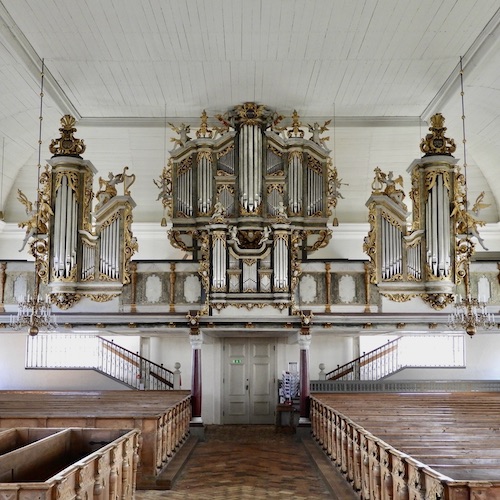CAHMAN
Lövstabruk Church Lövstabruk
Organ details
History
In 1726 Charles de Geer and Johan Niclas Cahman signed the contract for the organ. The contract describes a one-manual organ with pedal and 20 stops - 10 divided stops for the manual and ten for the pedal. Most likely the Rückpositif was added at the same time as the rest of the organ or slightly after. When the organ was finished in 1728 it was one of the largest organs in Sweden.
Johan Niclas Cahman (born in Flensburg 1679) was Sweden´s most important 18th-century organbuilder. His father Hans Hinrich Cahman (c. 1640 - 1699) was a companion to Hans Christoph Frietzsch. That means - J N Cahman built organs in the north German tradition and the organ in Lövstabruk has a clear north German structure with pedal towers on each side of the Manual cases.
Today the organ in Lövstabruk is the best preserved Cahman organ and the largest baroque organ in Sweden. During the period from 1729 until his death in 1737 Cahman built nearly 30 organs, including five in Cathedrals. Many of his organs were destroyed for various reasons, but the masterpiece in Lövstabruk survived almost completely intact thanks to the private ownership of the family De Geer. It has been used continuosly for 300 years except for one short period between 1912 and 1932. The bellows, wind chests, action and practically all the pipework survive with their original form and function, bearing witness to the technical and musical mastery of the organ builder. Johan Niclas Cahman organs were known for their high quality.
The Cahman organ in Lövstabruk is part of an early keyboard collection and musical library from the 18th century. In the manor house you find a Hieronymus Hass harpsichord (c 1728), an anonymous cabinet organ (c 1720 - 40), a Rangström clavichord (1775) and a Per Strand flute clock (ca 1770). The instruments are not in playable condition but show the importance the family placed upon high quality music. The 18th-century library contains chamber music, clavier music by the famous European composers of the time, such as Händel, Vivaldi, Albinoni and Rameau. There is also music written by the Swedish composers Roman, and Johnsen as well as some anonymous music that may be composed by Charles de Geer himself. In the 18th and 19th centuries the organist was employed by the noble family to play in the manor house as well in the church.
1728 The organ was build
1773 Repairs by Olof Schwan
1914 The Positiv was placed at the attic
1933 Reinstallation of the Positiv
1963 Restoration by Marcussen & Søn
2006 Restoration by Mats Arvidsson and Åkerman & Lund
2023 Restoration/reconstruction Trumpet 8 ft in Manualen by Karl Nelson
Multimedia library
Specification
| Ryggpositiv C-c3 | Manualen C-c3 | Pedal C-d1 |
| Gedact 8 Quintadena 8 Principal 4 Fleut 4 Quinta 3 Octava 2 Mixtur IV Vox Humana 8 | Quintadena 16 Principal 8 Rohrflöte 8 Quintadena 8 Spitzflöte 4 Octava 4 Quinta 3 Sup. Octava 2 Mixtur V Trompet 8 Manualen-Ryggpositiv | Offen Untersatz 16 Principal 8 Quinta 6 Gedact 8 Rausquint II Mixtur IV Bassun 16 Trompet 8 Trompet 4 Pedal-Manualen |




